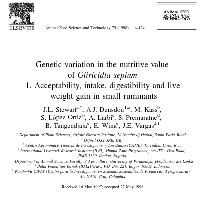Resumen
- There are widely varying perceptions of the acceptability of Gliricidia sepium (Jacq.) Steud. to ruminants in different parts of the tropics. The possibility that there is a genetic basis for this apparent variation was investigated in a series of feeding experiments with small ruminants. The same five provenances of G. sepium (three high-yielding provenances from the native range, plus two land races locally considered to be of high and low acceptability, respectively) were planted at sites in Indonesia, Sri Lanka, Costa Rica, Colombia and Nigeria. They were compared in terms of their relative acceptability and their effects on intake, live weight gain, and in vivo and in sacco dry matter disappearance. In preference tests, both sheep and goats could distinguish between provenances, and displayed a clear preference for local material (to which they had previous exposure). In seven trials where each animal received a single provenance, there was a significant effect of provenance on total intake in only one case, but this was not reflected in any significant variation in live weight gain or in vivo digestibility at any of the sites. Provenance differences in sacco dry matter disappearance were apparent at 24 and 48 h, but the differences were not consistent across sites. The findings of the study suggest that superior genetic material of G. sepium can be selected for fodder on the basis of growth and yield only, since there appears to be much greater within-species variation in yield than in nutritive value.
